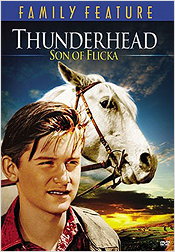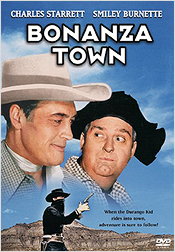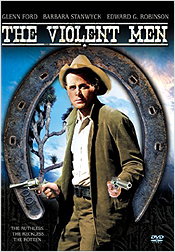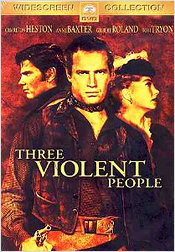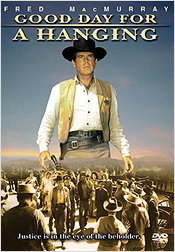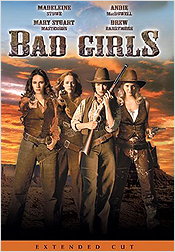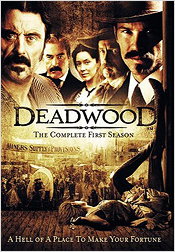 |
Site created 12/15/97.

page created: 4/28/05
 Back to Part One Barrie Maxwell - Main Page |
| Western
Roundup #1 - April 2005 (continued) Thunderhead, Son of Flicka (1945) (released on DVD by Fox on February 22nd, 2005) This is the second of three films made in colour by Fox from Mary O'Hara novels. The first, My Friend Flicka, proved to be a very successful 1943 adaptation of the family story about a young boy named Ken McLaughlin and a horse. Roddy McDowall starred as the boy and Preston Foster and Rita Johnson appeared as his parents. The same cast was reunited two years later for Thunderhead - Son of Flicka. (In 1948, the third film - Green Grass of Wyoming - appeared, but with an entirely new cast.) |
| Fox's
DVD presentation (correctly framed full screen) is quite nice. The
colours are fairly vibrant with some softness and colour
inconsistency intruding on isolated instances. Film grain is fairly
noticeable. The source material yields only some mild speckling in
the image. Both mono and stereo sound tracks are provided, but
there's little significant difference. Dialogue and sound effects
are clearly audible. A Spanish mono track and English and Spanish
subtitles are also provided. Supplements consist of the original
theatrical trailer and trailers for three other Fox releases.
Recommended. Red Ryder Double Feature, Volume 7: Great Stagecoach Robbery (1945) Phantom of the Plains (1945) Red Ryder Double Feature, Volume 8: Santa Fe Uprising (1946) Devil's Canyon (1947) (both released on DVD by VCI on December 28th, 2004) Republic Pictures was very successful in adapting Fred Harmon's Red Ryder character to the screen in the 1940s beginning with a serial (Adventures of Red Ryder) starring Don "Red" Barry in 1940. Four years later, the studio starred Wild Bill Elliott in its first series of Red Ryder westerns - 16 in all made in 1944 and 1945. Elliott made no particular effort to change his normal western forceful persona to fit the Ryder comic strip character, but the films were well-made and very popular as a result. A young Robert Blake co-starred as Little Beaver and Alice Fleming played Ryder's aunt, the Duchess. Following Elliott's departure into more prestigious westerns, Allan "Rocky" Lane took over the Red Ryder role for seven more pictures released during 1946 and 1947, after which Republic ceased involvement with the character. These too were good films with Lane providing an enthusiastic characterization. Robert Blake continued as Little Beaver, but Margaret Wentworth took over as the Duchess. Two years later, Eagle-Lion Pictures would make four lesser-regarded Red Ryder pictures starring Jim Bannon. |
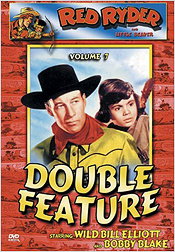 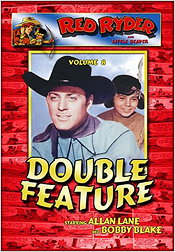 |
| Both
films included in Volume 7 are
Wild Bill Elliott efforts. Great
Stagecoach Robbery (robbery - yes, stagecoach - sort of,
great - no) finds Red Ryder involved in stolen money shipments that
implicate a convict recently released from prison who is attempting
to go straight. The tale includes the shocking (for a B western of
the time) murder of the convict's young grand-daughter. In Phantom
of the Plains (no plains, no phantom), the Duchess is
smitten with a British lord and Red Ryder has to come to her aid
when the lord turns out to be a phony, her money is taken, and her
murder looks to be next. Both films are entertaining B western fare.
While the stories are merely average, Elliott is great as a
no-nonsense Ryder and there are a number of well-staged action
scenes. Too bad you have to put up with the Little Beaver character.
The two films in Volume 8 are
Allan Lane entries. In Rustlers of
Devil's Canyon, Red Ryder, newly returned from the
Spanish-American War, must sort out a conflict between rustlers,
ranchers, and homesteaders. In Santa Fe
Uprising, the Duchess inherits a toll road that a gang of
outlaws is trying to take over. Red has to take on the job of town
sheriff in order to safeguard her interests. Both films are superior
entries, particularly the latter, which makes good use of Barton
MacLane and Jack LaRue as the chief heavies. In both films Allan
Lane is forceful, but also shows some vulnerability in his Ryder
portrayals. The Little Beaver character seems less obtrusive than in
the Volume 7 films. The action
is again well-staged in the usual Republic fashion and both films
benefit from the usual stable of Republic supporting players
including Roy Barcroft, Kenne Duncan, Edmund Cobb, Tom London, and
Dick Curtis. The source material used for the DVDs appears to be edited television versions, as each title runs from 52 to 54 minutes - some 4 to 6 minutes shorter than the original release times. VCI's disc of Volume 7 features transfers that have a bright image with fairly deep blacks and a reasonable level of image detail. There are plenty of speckles and scratches, however, and the disc pauses momentarily several times during the course of each feature as well as distorting briefly on one occasion. The Volume 8 transfers are slightly darker resulting in some night-time scenes that are quite murky. The events of the climactic mine fight in Rustlers of Devil's Canyon are almost indecipherable as a result. Volume 8, however, does not suffer from the pauses that characterize the other disc. The mono sound on both discs is workable, although there's plenty of hiss, crackle, and some distortion. Each disc contains similar packages of supplements - photo galleries of posters, lobby cards, and other Red Ryder comic strips and books; two chapters of the 1940 Adventures of Red Ryder serial; decent biographies on the lead players; and trailers for various Republic B westerns. B western fans should enjoy either of these discs, but disc quality limits my recommendation to Volume 8. The Sundowners (1950) High Lonesome (1950) (both released on DVD by VCI on March 29th, 2005) Alan LeMay is not exactly a Hollywood household name, although western aficionados will recognize him as the author of the books from which the films Along Came Jones (1945), The Searchers (1956) and The Unforgiven (1960) derived. Lemay, however, actually had quite a lengthy and generally successful run in Hollywood as a screenwriter and later a producer and director. In the 1940s while working mainly at Paramount, he wrote the screenplays for such films as Reap the Wild Wind (1942), The Story of Dr. Wassell (1944), San Antonio (1945), and Tap Roots (1947). As the 1940s came to a close, LeMay joined together with director George Templeton to form an independent production company called Arfran Productions, and thereafter much of his work focused on the western genre. The immediate fruit of the new company was the making of two Technicolor westerns both released in 1950 through Eagle-Lion - The Sundowners and High Lonesome. |
 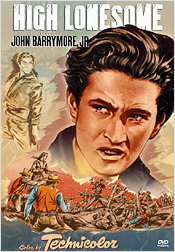 |
| Both
films are a little out of the ordinary from the usual run of minor-A
westerns. Each certainly offers short bursts of typical western
action, but overall there is a relaxed and thoughtful air to the
presentation of the stories, each of which runs about 82 minutes.
Based on LeMay's 1934 novel "Thunder in the Dust", The
Sundowners (not to be confused with the 1960 film of the
same title set in Australia) tells a fairly complex story of three
brothers, one on the wrong side of the law, who eventually cooperate
in a tale of rustling and murder. Robert Preston stars as the outlaw
brother while Robert Sterling and John Barrymore Jr. (in his debut)
appear as the other two brothers. Cathy Downs has a prominent
supporting role. High Lonesome
(the title refers to a region of Texas), one of the early so-called
psychological westerns, is a tale of a young drifter suspected of
several murders, but who maintains his innocence. Unfortunately for
him, those he describes as the real guilty ones seem to be two men
who have been dead for many years. John Barrymore Jr. (here billed
as John Drew Barrymore) stars with good support from John Archer
(father of actress Anne Archer) and Lois Butler. Beyond their
relaxed and thoughtful nature, both films have much in common
including themes of loners and strong independent women plus some
good location work on various ranches in Texas (the actual spreads
are listed in the opening credits to both films) and fine supporting
casts that include the likes of Chill Wills, Jack Elam, Clem Fuller,
and Frank Cordell. VCI presents both films on DVD correctly framed in full screen. The images, allowing for the fact that no particular restoration has been done, look quite nice, having been derived from the 35mm negatives. There are plenty of speckles and scratches and a few instances of missing frames, but the colour fidelity is good (slightly more vibrant in High Lonesome) and the images look quite sharp for the most part. Some of the night-time scenes look a little murky. The mono sound is clear on both films, but no subtitles are offered for either. Supplements are fairly similar on both discs. Each offers a half-hour episode of Stories of the Century - a modestly entertaining (though rather fanciful - see the story of Butch Cassidy and the Sundance Kid over 20 years reduced to 25 minutes in one of the episodes) western TV series produced by Republic in the early 1950s, biographies of cast and crew, and photo galleries. Recommended. Bonanza Town (1951) (released on DVD by Columbia on April 5th, 2005) In a past review column, I had some uncomplimentary things to say about the later Durango Kid westerns, not to mention the questionable value to consumers of packaging them as stand-alone titles at full price. I guess Columbia didn't take my comments to heart (what a surprise!) for here we are again with much the same situation for Bonanza Town. Charles Starrett is back as the Durango Kid, with Smiley Burnette along as his sidekick. This time, the story has to do with recovering $30,000 stolen in a holdup for the Treasury Department. The thief turns out to be an old nemesis of the Durango Kid, Henry Hardison, who is now controlling a lawless town with the help of local town boss Krag Boseman and a corrupt judge. |
| I
guess the only reason this particular Durango Kid title is out on
DVD is because it was previously issued on VHS and Columbia couldn't
be bothered to give any new thought to a good marketing strategy for
the series on DVD. That's a shame, for the film looks great - a nice
crisp transfer (correctly presented full frame) with some slight
grain and very minor speckling. The mono sound is quite adequate,
but there are no sub-titles. The only supplements are a montage of
scenes from Columbia westerns and trailers for Silverado
and The Professionals. The Old West (1952) Blue Canadian Rockies (1952) Wagon Team (1952) (released on DVD by Image on January 4th, April 5th, and April 19th, 2005 respectively) Image has released three more Gene Autry westerns on DVD over the past few months. All are from 1952, the second last year of Autry's Columbia period and offer much the same blend of songs, mild action, simple stories, and Gene's amiable but somewhat wooden acting style. These are for Gene Autry fans only, as they pale in comparison to the better B westerns of earlier years. |
 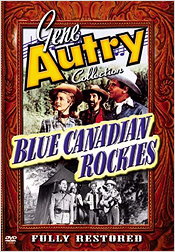 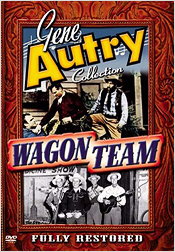 |
| In
The Old West, Gene intervenes
in a dispute between competing stagecoach lines and manages to
subdue bad guy Doc Lockwood (Lyle Talbot) despite suffering a
serious gunshot wound. Gail Davis appears as the owner of the line
for which Gene is working and Pat Buttram provides comic relief.
Blue Canadian Rockies finds
Gene trying to sort out an attempted murder at an operation trying
to make a go of a dude ranch and game preserve in the midst of
logging country. Gail Davis and Pat Buttram once again co-star,
while veteran Tom London has an important role. In Wagon
Team, Gene attempts to track down a young army-payroll
thief, but he has competition from a gang of robbers who want the
payroll themselves. Former child star Dick Jones plays the young
thief while Gail Davis and Pat Buttram appear once again. The Cass
County Boys also provide musical support in both of the latter
films. There is little to choose between the three films in terms of
overall entertainment value. If it's the musical content that you
appreciate best in the Autry films, all fill the bill. If it's
western action that you prefer, these are all light in that respect,
both in terms of quantity and style of execution. As with all of the Autry films released by Image so far, the black and white source material has been restored and the DVD images (presented correctly full frame) are quite pleasing. Along with the Hopalong Cassidy films, they're generally the best-looking of any B westerns available on DVD. The transfers provide bright, clean, and quite crisp images with good shadow detail and no edge effects. The Old West is perhaps slightly softer-looking than the other two. The mono sound is clear with negligible hiss. There are no sub-titles. Each disc has the usual set of supplements - the conversations between Gene and Pat Buttram recorded for use on the Melody Ranch Theater program that aired the films on television, production and publicity stills and poster art, excerpts from the original Melody Ranch radio show, press kit material, and the original theatrical trailer. Recommended for Gene Autry fans. The Violent Men (1955) (released on DVD by Columbia on April 5th, 2005) Columbia has released a whole slew of westerns new to DVD this month and this is the best of them. Filmed in the unforgettable Lone Pine area of California, The Violent Men has all the elements of a top-notch western - a first-rate cast, beautiful photography, a classic story, plenty of action, and a lush score to back it all up. Ex-Confederate soldier John Parrish, after a lengthy recovery from wounds suffered during the Civil War, plans to sell his ranch and move east to get married. The prospective purchaser is the vast Anchor Ranch, Parrish's neighbor and an outfit intent on gaining control of the whole valley. An insultingly low offer from Anchor's owner, the crippled Lee Wilkison, followed by the brutal murder of one of Parrish's men, leads Parrish to rethink his plans. As Parrish considers ways to retaliate, Wilkison has his own difficulties. His wife Martha secretly despises her husband and plans to take over Anchor along with Wilkison's younger brother Cole. An explosive range war breaks out leading to double-dealing and murder. |
| Columbia
presents the film on DVD in a 2.55:1 anamorphic transfer (despite
ambiguous packaging that states "2.55:1 full screen") that
is very pleasing. There are some signs of wear on the print, but the
image is quite sharp with very good contrast and colour fidelity.
There are no edge effects. The Dolby Digital 3.0 stereo score offers
some nice separation effects and is complimentary to Steiner's
score. Supplements are limited to a two-minute montage of scenes
from various Columbia westerns and trailers for Silverado
and The Professionals. Highly
recommended. Three Violent People (1957) (released on DVD by Paramount on April 19th, 2005) Charlton Heston played in a number of westerns during his career and for the most part, his efforts provided successful entertainments. Arrowhead, The Big Country, and Will Penny are several good examples. Three Violent People (working title, Maverick) proved to be one of the less interesting ones. Filmed on location in Arizona though set in Texas, Heston plays Civil War veteran Colt Saunders who returns to his ranch picking up new bride Lorna (Anne Baxter) along the way. Once there, he is faced with preventing the corrupt provisional government from attempting to take over his ranch. Initially, Saunders has the support of his brother (Tom Tryon), wife, and a loyal band of Vaqueros (headed by Gilbert Roland) who have helped manage the Saunders ranch for years. Eventually, however, a wedge is driven between them and Colt due to his intransigent attitudes, leaving the field wide open for the provisional government's crooked representatives to pounce. |
| Paramount's
1.85:1 anamorphic presentation of the VistaVision film is its usual
competent effort. The image looks crisp and clear with
accurate-looking colour. There are no edge effects and source
material defects (scratches, speckles) are minimal. The mono sound
is undistinguished. English subtitles are provided, but there are
typically for Paramount no supplements. Good Day for a Hanging (1958) (released on DVD by Columbia on April 5th, 2005) After a few westerns early in his career (The Texas Rangers [1936], Rangers of Fortune 1940]), Fred MacMurray hit the saddle again in earnest in the mid-1950s like many of his contemporary male stars. MacMurray seemed like the least likely of that bunch to make an effective western player, but his efforts usually turned out quite well, focusing as they did on modest character studies rather than full-blown western spectacles. Good Day for a Hanging is a fine example. In it, MacMurray plays former marshal Ben Cutler who finds himself part of a posse pursuing a gang who have just robbed the town bank. Ben witnesses one of the gang, Eddie "The Kid" Campbell - a youngster whom his daughter has known growing up - shoot and kill town marshal Hiram Cain. Eddie is captured and tried for Cain's murder, but his lawyer is able to create doubt as to Eddie's guilt in all the members of the posse except for Ben Cutler. His testimony results in Eddie's conviction and subsequent sentencing to be hanged. By now Ben has agreed to serve as interim marshal and the task falls to him to carry out the execution. But what seemed like a straight-forward affair soon becomes clouded, isolating Ben from the rest of the townspeople. |
| Columbia
has released the film with a 1.85:1 anamorphic transfer, but the
Columbia Color has not aged well. The image lacks vibrancy and
frequently seems faded. A fair amount of film grain is in evidence
as are speckles and some scratches, adding in this case to the
film's rather lacklustre look. The mono sound is workmanlike,
neither adding nor subtracting from the experience. English and
Japanese subtitles are provided. Supplements consist of a montage of
scenes from various Columbia westerns and trailers for Silverado
and The Professionals.
Recommended as a rental. Bad Girls (1994) (released on DVD by Fox on February 1st, 2005) The idea of a western film centered around four women would be a pretty good one if presented realistically. Unfortunately, Bad Girls is a piece of fluff that leans more to the nature of an old B western with a well-dressed hero than the grit of an Unforgiven to whose popularity this 1994 film undoubtedly owes its existence. The only tip of the hat to the more modern western is a rather blatant though modest attempt to rip off the ending of The Wild Bunch. Given all that, and in the right mood to be entertained by fluff, Bad Girls can be an amiable time passer just as some of the glossier B westerns of the mid 1940s (such as some of the Roy Rogers musical extravaganzas) could be. |
| Fox's
1.85:1 anamorphic transfer is very nice. It provides a generally
crisp transfer characterized by vibrant colour and realistic flesh
tones. There is a minor hint of edge effects from time to time, but
the overall impact is very favourable. A full frame transfer is also
included on the flip side of the disc. The Dolby Digital 5.1
surround track is very pleasing. It provides effective use of the
surrounds and good front separation. Action sequences have good
sonic presence without being exaggerated. French and Spanish stereo
tracks as well as English and Spanish subtitles are provided. The
only supplements are two trailers, although the release is billed as
an extended cut that apparently adds a minute or so to the
theatrical cut. Deadwood: The Complete First Season (2004) (released on DVD by HBO on February 8th, 2005) With the western genre in the doldrums, it took some nerve for HBO to go ahead with a new western series called Deadwood. It was a gamble that paid off though, as the series scored heavily with viewers and brought considerable awards attention from the Emmys and Golden Globes, among others. The series documents events in the wide-open frontier town of Deadwood, South Dakota in the days of the Black Hills gold strike soon after Custer's last stand at Little Big Horn. It's almost impossible to do justice to the story line in a few sentences here, so intricate and layered is it. The first season's twelve episodes follow the fortunes of a disparate group of characters including the legendary Wild Bill Hickok and Calamity Jane. But this is no standard western telling of the lives of those characters. They are simply two of an amazing group of outlaws, settlers, prospectors, ex-lawmen, whores, businessmen good and bad who inhabit Deadwood in those early days. At the centre of it all is saloon owner Al Swearengen (Ian McShane) who sees the possibility of a profit in every situation and acts as the de facto town boss and magnet for the town's illegal and immoral activities. On the opposite side of the fence are former lawman Seth Bullock (Timothy Olyphant) and Hickok (Keith Carradine). Somewhere in between are the likes of Doc Cochran (Brad Dourif), Seth's partner Sol Star (John Hawkes), hotelier E.B. Farnum (William Sanderson), laudanum addict Alma Garret (Molly Parker), Calamity Jane (Robin Weigert), and many others who come and go. Each character is distinct and richly drawn in episodes that vary from action-filled to intricately-drawn character studies. It may take you an episode or two to get into the series, but once in, you're hooked. |
| The
episodes benefit from a very skilled cast each of whom seem deeply
immersed in their characters. Of course, the excellent writing is a
big contributor, but the actors all make the most of the material.
Every one seems like a real, distinct individual and all have at
times in the various media coverage of the series been duly
recognized. I suspect that every viewer will have their personal
favourite, but it seems clear that there is virtually universal
approval of the work of Ian McShane as Swearengen. I certainly
concur. It's a richly drawn evocation of a complex character. For
me, Keith Carradine and Timothy Olyphant also score heavily, and I
always enjoy Powers Boothe's efforts (even if a lesser one here). Warner Bros. has issued the complete first season in a six-disc box set. The twelve episodes are contained on the first five discs (either two or three episodes per disc) while the last disc is reserved for the bulk of the supplementary features. The episodes are presented in 1.78:1 anamorphic transfers that look impressive. The image is sharp and colour fidelity is very good (although colours are subdued reflecting the way the material was shot). Image detail is very good, although there is an excessive loss of detail in a few dark scenes. A Dolby Digital 5.1 sound track provides a strong sound stage across the fronts, but there is but infrequent use of the surrounds. Dolby 2.0 tracks are also provided in English, French, and Spanish as are corresponding sub-titles. The supplements include audio commentaries on four episodes (David Milch on episode 1: Deadwood; Molly Parker and Keith Carradine on episode 4: Here Was a Man; Brad Dourif and Robin Weigert on episode 5: The Trial of Jack McCall; and Ian McShane and Timothy Olyphant on episode 12: Sold Under Sin). None are startling commentaries, but all are informative and reasonably diverting, the one with Dourif and Weigert probably being the best of the bunch. The rest of the supplements consist of four featurettes. Two of them (comprising almost an hour of material) feature Carradine and Milch in conversation on the language used in the series (The New Language of the Old West) and on the blending of historical and fictional characters (An Imaginative Reality). The third one talks about the real town of Deadwood and its history, while the fourth is a fairly standard making-of effort. All four are worth your time. Highly recommended. Forthcoming Westerns on DVD I've created a table of upcoming western films on DVD. This is partially a subset of the classic film database, but in the spirit of this column includes all westerns, not just those originally released prior to about 1970. The next few months include quite a number of westerns among the various DVD releases on tap, as traditionally the spring months are the most popular for western releases. There is another lesser bump in mid-autumn. Some of the highlights are summarized below. For the complete listing, please click here. Looking over the line-up for the April-to-June period, virtually all the studios are active in western releases. Warner Bros. has some Errol Flynn and John Wayne efforts, as well as several more-recent Turner cable westerns. Columbia has two cycles of releases, a large one in early April that includes a lot of 1940s and 1950s titles (e.g. Desperadoes, Lust for Gold, Jubal, The Violent Men) and a smaller one in late May that includes an early Tim McCoy outing. Fox pumps out seven titles in late May featuring the likes of Henry Fonda, Spencer Tracy, Gregory Peck, and Barbara Stanwyck among others. In mid May, MGM has five titles mainly from the 1960s (highlighted by Hour of the Gun) while Paramount sprinkles titles throughout April, May, and June (Johnny Reno, Waterhole #3, The Reivers, Three Violent People, Branded, etc.). Universal, which usually comes through with a slew of westerns at this time of year, has so far only announced The Appaloosa (as part of a Brando set). On the horizon are several other highly anticipated releases: a restored version of Major Dundee from Columbia originally expected May 31st, but now apparently delayed until August 30th; new SEs of A Fistful of Dollars and For a Few Dollars More (although actual timing is an issue what with the acquisition of MGM by Sony); and several John Wayne westerns (e.g. Hondo, McClintock! - originally produced by Wayne's company Batjac) that were acquired by Paramount for DVD release beginning later this year. For B western and serial fans, the usual state of affairs seems likely to persist. Many such films are in the public domain so that whenever versions are released, the results are usually less than ideal as the source material has normally not been restored. Still, VCI normally puts out a good product and so expectations for three 1930s serials (including two with Johnny Mack Brown) on May 31st are promising. Among the films of the major B western stars, only those of Gene Autry and Hopalong Cassidy have received restoration efforts. Image has systematically been releasing the former and two titles are planned for mid April (Blue Canadian Rockies, Wagon Team). There are currently no further Cassidy westerns announced from Platinum who have handled the most recent quality releases. A June 7th release of a Cassidy triple bill from Falcon Picture Group should probably be avoided. There are plenty of other B westerns coming out from Alpha and other public domain specialists including numerous independent outfits that issue DVD-R versions, but only Alpha seems to make its plans readily available so its releases are included in the database. In all such cases, it's always a case of buyer beware. Some titles are very good; some are very bad. Word-of mouth is your best bet on such sources. Well, that should keep you western addicts going for a little while. There's lots of good fare coming up and I look forward to returning with more reviews and western DVD information later this spring. See yuh then, pardners! Barrie Maxwell barriemaxwell@thedigitalbits.com |
Barrie Maxwell - Main Page
 |
| Site
designed for 1024 x 768 resolution, using 16M colors and .gif 89a
animation. © 1997-2015 The Digital Bits, Inc., All Rights Reserved. billhunt@thedigitalbits.com |
